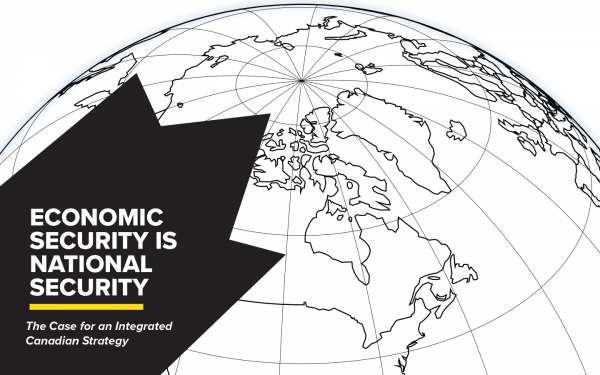Strengthening education and research connectivity between Canada and Asia: Innovative models for engagement
Abstract
Education, innovation and knowledge are key drivers in the world economy. Led by China and India, the emerging economies of Asia have placed a premium on investing in higher education and on building academic and research links around the globe. Canada must do the same, embracing an international education strategy that recognizes the importance of education as a way of deepening our relationships with Asian countries. Canada must brand itself as a partner of choice in higher education and research, and recruit Asian students and researchers to come here to study. At the same time, we must invest more in study and workabroad programs for Canadian students, and must be deliberate about fostering academic collaboration with Asia through joint academic programs, joint supervision of PhD students, and faculty mobility. We need to find new ways to export our expertise in higher education and leverage our alumni networks, making Canadian expatriates and former international students ambassadors for Canadian higher education. The personal connections made by Canadians who study in other countries, and by foreign students in Canada, can result in long-term economic, social and cultural ties. The private sector can play a leadership role in this process by providing internships and funding for student mobility. Canada’s universities are often at the forefront of engagement with developing economies. As such, they are an asset that both government and the private sector can work with to advance our country’s place in the world.
Résumé
L’avenir du Canada et celui des pays du monde sera façonné par un nombre croissant de citoyens du monde créatifs, hautement qualifiés, instruits et ambitieux. Dans un monde d connecté et interrelié, les liens interpersonnels sont essentiels, car Ils contribueront à établir des liens économiques, sociaux et culturels forts et durables entre les pays. Alors que le monde continue d’éprouver des difficultés économiques, il deviendra de plus en plus important de bien comprendre ses voisins internationaux. La croissance des économies asiatiques présente une belle occasion pour le Canada. Pour la saisir, la Canada doit élaborer une stratégie d’éducation internationale qui reconnaît l’importance de l’éducation comme moyen d’approfondir nos relations avec les pays d’Asie. Le Canada doit se démarquer comme partenaire de choix en éducation supérieure et en recherche avancée et recruter des étudiants et chercheurs asiatiques à venir étudier ici. Nous devons aussi investir davantage dans des programmes d’étude et de travail à l’étranger et chercher délibérément à développer une collaboration entre le milieu universitaire de l’Asie en concevant des programmes conjoints, en supervisant conjointement des étudiants au doctorat et en favorisant la mobilité des enseignants. Les programmes d’éducation canadiens doivent être adaptés pour aider les étudiants à approfondir leurs connaissances et leur compréhension de l’histoire, des cultures et des langues asiatiques. Nous devrons compter sur le leadership du secteur privé, sous forme d’internats et de financement de la mobilité des étudiants. Grâce à son économie relativement forte, le Canada a l’occasion d’investir dans la collaboration internationale en matière de recherche qui apportera des avantages pour les années à venir. Le Canada devrait trouver d’autres moyens d’exporter notre expertise en éducation supérieure et de mettre en valeur nos réseaux de ressources existantes, faisant des expatriés canadiens et des anciens étudiants internationaux des ambassadeurs de l’éducation supérieure canadienne. Les universités canadiennes sont souvent à l’avant-garde de l’engagement avec les économies en développement et elles servent d’important partenaire du gouvernement et du secteur privé en assurant la prospérité économique et sociale à l’avenir.
Introduction
A university education is a transformative experience. Universities help us navigate in a profoundly changing and challenging world. They create, connect and integrate knowledge. They link us across cultures and across borders.
Universities also transform countries. This fact is nowhere more evident than in Asia. Led by India and China, in recent years Asia has been taking an increasingly dominant role in the global economy. Rapid growth is affecting all aspects of the region’s economy and society, with changes closely influenced by demographic trends such as large cohorts of young people and an expanding middle class. Demand for higher education in Asia has been rising steadily in response to these trends and to the labour market needs of today’s knowledge-intensive economy.
For Canada to prosper and compete in the global economy, we need to take advantage of the many opportunities Asia’s prosperity and growth will bring. Canada’s future – indeed, the future of countries around the world – will be shaped, from within our borders and outside of them, by changes wrought by a growing population of creative, highly trained, well-educated and ambitious global citizens. The emerging leaders of the 21st century global economy have placed a premium on investing in higher education and in building academic and research links around the globe.
Canada must do the same. Unprecedented demand for higher education in Asia today offers a multitude of opportunities for Canada, from institutional
partnerships to facilitate research, to the recruitment of talented international students and researchers, to new markets for Canadian knowledge exports.
The government of Canada recognizes that education, innovation and knowledge are key drivers in a world economy. In its 2011 budget, the federal government announced the development of a new Canadian International Education Strategy. In October of the same year, it named an expert advisory panel, which is about to release a report with recommendations aimed at deepening educational and research links between Canada and international institutions. The government confirmed its commitment to establishing a strong and coherent international education strategy in its 2012 budget, when it said, “Attracting more international students and researchers to Canada will create jobs and economic growth, expand our people-to-people ties in markets, showcase Canadian research excellence abroad, help produce more skilled workforce and foster close ties between Canadian and international educational institutions.”
I believe firmly that the people-to-people connections we are building through institutional cooperation and academic mobility lead to strong and sustainable economic, social and cultural ties. Canada must make significant investments to foster and maintain these personal linkages, leveraging the ongoing efforts by our universities and encouraging the participation of new stakeholders in international education. The intercultural knowledge, skills and networks that are built in this sector are essential for individuals and businesses to thrive in today’s global economy. The personal connections made by Canadians who study in other countries, and by foreign students in Canada, can result in long-term economic, social and cultural ties. Given this reality, there is a clear opportunity – and incentive – for greater private sector involvement.
Top 10 Steps to Position Canada as the Education Destination and Partner of Choice for Asia
1) A cohesive international education strategy
The international education sector, like many others in Canada, is complex and multifaceted. There are numerous government and non-governmental players and each has a complementary role in the development and implementation of a truly effective national strategy. This strategy should reflect the centrality of international education to Canada’s future prosperity and quality of life.
Education must become a pillar of Canada’s foreign policy and economic growth objectives. Senior leadership engagement – in both the public and private sectors – is essential to demonstrate to Asian partners that Canada’s commitment to international education is strong and sustainable. The federal government can act as an enabler and facilitator, opening new doors for research and mobility partnerships between Canadian and Asian institutions.
In the case of China, university enrolment has been rising at a staggering rate since the 1990s, particularly over the past decade. Between 2000 and 2010, graduate student enrolment alone grew from 283,000 to 1.5 million, while total enrolment in higher education reached 22.3 million by the same year
It is critically important that the international education strategy be led by the education community. Education groups, including universities, colleges, schools and language schools, are already making inroads in a cohesive, pan-Canadian approach to international education.
It is also important to make sure the strategy is robust and at scale. To date, Canada has been limited in fully leveraging Canadian universities’ international linkages for three reasons:
- Previous government initiatives have been episodic and sporadic, and were often the focus of cuts at the first sign of a downturn;
- Our efforts are diffuse – institutional, provincial and federal initiatives have not worked together effectively to advance Canada’s interests; and finally,
- We have trouble getting to scale – there have been many pilot programs that demonstrate excellent value but that never achieve the scale necessary to generate truly transformative results.
Diplomacy in the 21st century goes far beyond interactions between government actors. Higher education institutions, private industry and civil society all make invaluable contributions to the development of enduring people-to-people ties. A national, collaborative approach to international education is needed to leverage investments made by all stakeholders and to align activities with a series of common goals.
2) Build the Canadian brand
Countries long established in the international education market, such as the United States, United Kingdom and Australia, have strong brands and communicate them effectively.
To make an impact, Canada must firmly, intentionally and creatively position the Canadian university community in Asia to succeed as both a destination for talented students and researchers, and a vital partner at the institutional level. Asian countries have rapid-growth economies and rapidly changing higher education landscapes – factors that can pose challenges to individual universities in terms of navigating the system, identifying ideal partners and tracking ongoing market developments.
Key to the success of Canada’s international education will be the strong branding of quality Canadian education, and a collaborative approach to marketing the excellence of Canadian higher education. Canada offers an education experience that is of excellent quality, affordable and provided in a safe and welcoming environment.
We must make targeted investments now to build this brand of excellence in countries of strategic priority, such as India and China. We must also present a united front to the world. The federal and provincial governments, the private sector, and the education sector must work together at scale to brand Canada as a partner of choice in higher education and research.
3) Targeted recruitment of Asian students and researchers
Canada has a window of opportunity to establish itself as a premier destination for students at all levels, especially in the key target markets of China and India. Competitors such as Australia and the United Kingdom are facing policy challenges that are expected to reduce demand from international students. We must act quickly to strengthen Canada’s position as an ideal destination for the most talented students and researchers.
Asia is already the largest source of international students in the world, and the number of Asians looking to study abroad is expected to continue to rise in the coming years. In the case of Canadian universities, half of our top 10 source countries for international students are in Asia.
China has been Canada’s top source country for international students for many years, representing close to one-quarter of international undergraduate and graduate students in Canada in 2009 with 23,400 students (19,100 full-time and 4,300 part-time students). Other key Asian markets include India (four percent), South Korean (four percent), Japan (two percent) and Hong Kong (two percent). With sustained effort and clear intention, Canada has begun to make progress in India, and we have seen an increase in the number of students coming to Canada from India. India is now the sixth ranked source country for full-time international students on Canadian university campuses.
Competition for global talent is intensifying alongside the growth in mobility of Asian students – especially at the graduate level. While Canada’s universities have been increasingly successful in recruiting international students – more than doubling in number in the past decade – targeted and sustained investments are required to attract top talent to our campuses.
The Canadian government recently introduced the high-profile Vanier Canada Graduate Scholarships and Banting Postdoctoral Fellowships to attract and retain world-class Canadian and international talent, and to position Canada as a global centre of excellence in research and higher learning. In announcing the winners of these scholarships last year, Prime Minister Stephen Harper called them “a key source of entrepreneurial innovation and creativity.” A modest number of other scholarships are also offered by the government to attract non-Canadian students to Canada.
Beyond these programs, individual institutions are already investing significantly in recruitment efforts, including allocations to scholarship programs for international students. These initiatives have established a strong foundation that now needs to be strengthened and brought to scale in order to meet Canada’s ambitions in the world.
More can be done, however, to put Canadian higher education on the map and attract top-notch international talent.
A high profile, Canada-branded scholarship program is needed to attract top quality students and researchers. This would include scholarships for undergraduates, and could also see significant ramping up of the Vanier graduate scholarships. Canada’s scholarship program should be built upon strategic partnerships between key Canadian stakeholders, including governments, private industry and higher education intitutions.
4) Two-way short term mobility
Our future, increasingly, is shaped by global, quickly moving and interconnected forces. To understand these challenges, Canada needs people with knowledge of other countries, languages, and cultures, and an ability to establish partnerships with colleagues from around the world. Canadian universities continue to recognize the importance of creating meaningful international learning experiences for their students. These experiences help students to develop intercultural skills and prepare graduates for success in today’s knowledge-based economy. We are committed to enhancing the learning experience of undergraduate, graduate and professional students by drawing on a full range of educational, research-based and community-focussed opportunities enriched with global engagement and new technologies.
Although we know that Canadian university students are interested in a wide range of international mobility opportunities, fewer than three percent gain international study experience for credit in a given year. Financial considerations are often cited as the most significant hindrance to participation in international academic exchanges, research collaboration and internships.
Our partners outside Canada are concerned about the paucity of Canadians studying in other countries. The imbalance is seen as representing a lack of commitment by Canada to true partnership and evidence of provincialism – not ideas that a robust internationally engaged Canada would want to foster.
While financial barriers are not unique to Canadian students, many other countries address this challenge by investing in study-abroad programs. For example, Germany has made significant investments in student mobility, including the equivalent of more than $36 million euros in funding for study-abroad scholarships in 2010 alone.6 A recent survey revealed the impact of these funds: close to a third of all German university students go abroad for part of their studies.
I have seen first-hand the benefits of study abroad in my own life and that of my family. A pan-Canadian international student mobility program, with funding from both the government of Canada and the private sector, can help students gain the international experience essential for their ability to contribute to the global economy. This program should include opportunities for both short-term and long-term study, work and research abroad. Private sector involvement will be key to providing students with hands-on experiences through internships or similar opportunities.
5) Developing key institutional partnerships
Institutional partnerships create a solid foundation for all aspects of international education, including student and faculty mobility, research collaboration, and joint academic programs. The most successful relationships involve a balanced equilibrium in power and effort – a general rule that holds true in this field. We must help Canada to stand apart from its competitors by creating a model that highlights our unique strengths as a partner in international education, not simply as a recruiter.
Canadian universities are committed to cultivating meaningful engagement and partnerships, both at home and abroad. We develop bilateral agreements with other academic institutions to create new opportunities for our students to gain international study and research experience. We invite partnerships with businesses to combine our resources in order to research and implement solutions to local and global problems.
Mitacs, a national, not-for-profit research organization, offers innovative research and training programs. Leveraging collaboration among government, academia and private industry, these programs allow top students and researchers from around the world to develop high-quality research expertise in Canada.
Canada must be deliberate about building academic collaboration with Asia, rather than relying solely on our traditional partners such as Europe or the United States. This collaboration can include the development of joint academic programs (i.e. joint or double degrees), joint supervision of PhD students (i.e. co-tutelles), faculty mobility, capacity-building of faculty and university administrators, and the development of innovative approaches to ensuring both Canadian and Asian students benefit from a globally enhanced learning experience during their academic career.
The mobility of faculty plays a key role in bringing together students, institutions, and researchers. Often, faculty members are the drivers of specific academic collaborations that grow into institution-wide, long-term partnerships between universities. Developing joint academic programming, introducing innovative learning practices that flow across borders, and using ICT to facilitate collaboration are all key to ensuring that Canada builds knowledge links today that we need for our future.
6) Internationalize curricula in Canada
Ideally, all Canadian students and faculty would gain first-hand international experience through academic exchanges, research placements or internships. As we build towards this objective, Canadian universities are also pursuing other avenues to internationalize our institutions and offer globally enriched learning experiences on campus. The internationalization of curricula is one example of these efforts, which involves the inclusion of intercultural and global dimensions in course content and teaching methods. Key strategies to integrate international elements into curricula include involving international scholars and visiting experts; encouraging incoming international student mobility opportunities; using international or intercultural case studies; and developing joint programs with international partners.
More than 80 different programs related to Asian studies are offered at universities across Canada, including coursework related to Asian cultures, literature, languages and public policy
There is a particular need to incorporate more Asian content into Canadian educational programs, from kindergarten to university. To prepare graduates to work in the global workforce – one increasingly shaped by Asian economies – young Canadians must have greater exposure to the histories and cultures of Asian countries. A strong emphasis should be placed upon the development of Asian language study programs. Canadian students also need to know much more about how Asia Pacific researchers are changing the dynamics of science around the globe, a trend I wrote about earlier this year in Science.
7) Leadership from the private sector
Universities are committed to reaching beyond their own institutions to create alliances, partnerships and initiatives of shared purpose. On the international education front, business leaders can make a key difference in ramping up international education commitments, making them meaningful and ensuring success. Take, for example, Brazil’s Science without Borders program. This initiative will enable 101,000 Brazilian university students and scholars to study and conduct research abroad over the next four years. The Brazilian government is funding 75,000 Brazilian students. The Brazilian private sector has stepped up to fund an additional 26,000 scholarships. This innovative program will strengthen and expand innovation and competitiveness through the international mobility of undergraduate and graduate students and researchers.
During a recent mission to Brazil of 30 Canadian university presidents, organized by the Association of Universities and Colleges of Canada (AUCC) and led by the Governor General, it was announced that Brazil will send up to 12,000 of these students to Canada. Canadian business leaders are now stepping up to ensure that these students receive an integrated experience while in Canada, including not only language and postsecondary study, but also hands-on internships in private industry.
Groups such as the Canadian Council of Chief Executives and the Canadian Chamber of Commerce can play a leadership role by raising awareness of the importance of study- and work-abroad experiences for Canadians – and they can join the effort to secure funding to make these opportunities a reality for many more young Canadians.
8) Invest in international research collaboration at scale
Today’s knowledge environment is global. Talent comes from everywhere. The world’s best minds must be concentrated on the world’s toughest problems to create, communicate and apply new knowledge to effect tangible, positive change in the world. Like the strongest economies, the top students and researchers are globally engaged and mobile.
Research is a primary driver for Canada and we thrive by providing a supportive environment for talent. Universities, aided by federal and provincial governments, have worked to create the conditions that attract talent from around the world, and that keep talented Canadians here, enabling them to do their best work at home. All of Canada participates in and benefits from this enterprise, which requires not only advanced research facilities but also lively, safe, diverse and inclusive communities that serve as magnets for people who could choose do their work anywhere on earth.
Given the comparative strength of the Canadian economy, we have an opportunity to invest in international research collaboration that will pay dividends for decades to come. Asia’s science and technology environment is also a potential source of stimulus for Canada’s own research sector and economic competitiveness. Countries such as Singapore and Japan have well-established research and development programs, while countries such as China and India continue to build their domestic capacity.
Countries around the world, including emerging nations, are making significant investments in research and development. China’s investment has risen dramatically, to $154.1 billion USD in 2009.11 China awarded 48,700 doctorate degree in 2009 (compared to Canada’s 5,700). In 2009, China overtook Japan as the world’s second-largest investor in R&D afer the United States.
India is building a National Knowledge Network that will see a $20-billion USD investment in cross-country broadband infrastructure to connect education institutions and research centres, with the goal of democratizing information.
Regardless of location, Canadian universities are well-positioned to tap into collaborative research networks with their Asian counterparts. Although many institutions are already actively engaged in these types of partnerships, additional investments are needed to sustain and accelerate the pace of research to address highly complex issues. Given opportunities for commercialization, research is an ideal area for joint investments by the public and private sectors. A significant global research fund, at the federal level and awarded competitively through the granting councils, would enable international research collaboration at scale and would facilitate the participation of Canadian students and faculty in international research projects.
9) Knowledge exports
Rapid growth in Asia’s education sector has also created new opportunities for Canada to export its expertise in higher education. As many Asian countries strive to expand and sustain their higher education system, Canadian universities are well-positioned to collaborate in curriculum development, pedagogy, research and mentoring university administrations.
Canadian universities are not widely engaged in developing full offshore campuses. While these work well for some professional programs, they are generally less effective than building genuine partnerships. However, virtually all Canadian universities are engaged in pursuing knowledge export opportunities around the world. These opportunities may include educational programs offered abroad (often through local host institutions), distance education programs, exporting Canadian curricula to partner institutions, franchising courses and programs, or providing education services abroad (specific courses, training, consulting, professional development programs, etc.).
Some programs can be more easily offered abroad than others. Canadian business schools, for example, are leading the way into key markets. York University’s Schulich School of Business has been offering its MBA curriculum to Indian students through an Indian partner, with the students completing the program in Toronto, and is preparing to launch a full MBA program in Hyderabad as soon as India’s Parliament approves legislation granting foreign institutions the right to set up campuses and offer degrees.
My university’s Sauder School of Business, meanwhile, already offers more than 30 programs in China and Canada for senior government and business executives. To date, some 500 senior Chinese leaders from cities such as Beijing, Shanghai, Guangzhou and Fujian have taken part.
Building on Canada’s reputation in the provision of high-quality higher education, we can create a strong knowledge-export industry to help Asian countries meet their need for post-secondary education.
10) Leverage international alumni networks
So often when I travel abroad, I meet alumni of Canadian universities who are eager to share with me the value of their education and experiences in this country. You will find them at the highest levels of government, running major corporations and small businesses, writing for newspapers, teaching young people or developing innovative products.
Today, we are reaping the benefits of shrewd investments made decades ago to bring international students to Canada. Transformed by their experiences in Canada, many international students return home after graduation and become leaders in their fields. The powerful and life-changing experiences they had while studying in Canada often leave a lasting impression on their career paths. Canadian university alumni become ambassadors for Canada, facilitating international partnerships and trade in both the public and private sectors. A concerted effort should be made to harness the potential for alumni to fulfill this role as ambassadors. Who better to speak to the Asian market than Asian voices about their experiences in Canada?
During an AUCC-led visit by 15 Canadian university presidents to India in November 2010, a group of Indian alumni of Canadian universities launched the India-Canada Alumni Network (I-CAN). This is a dedicated group of young professionals who have earned university degrees at Canadian institutions, and who have come together to share experiences and encourage younger students to consider Canada as a study destination. Through targeted alumni events in key Asian markets and the power of social media, Canada can build ever-stronger ties.
International Higher Education as a Gateway to Asia
We must recognize that active engagement in international higher education acts as a gateway to closer bilateral and multilateral ties in all sectors. Given the concrete benefits that international students bring to Canada and the need for Canadian students to gain inter-cultural knowledge and skills to succeed in the global economy, it is clear that we must be intentional about engaging more broadly and deeply with powerful Asian economies. We are past the point of relying on our traditional markets – many of which are experiencing difficult and troubling economic setbacks.
Already, signs are encouraging. The government of Canada is increasingly recognizing the important role of higher education in what our Governor General, His Excellency the Right Honourable David Johnston, calls the “diplomacy of knowledge.” The government understands the value of academic links and collaboration in driving trade and building social, political and economic ties with the rapidly developing economies of Asia. In 2010, the government of Canada and the government of India signed a Memorandum of Understanding on higher education cooperation. In 2011, the Governor General led a mission of key academic and business leaders to Vietnam, Singapore and Malaysia, with a strong focus on education, research and innovation. In February 2012, Prime Minister Stephen Harper visited China, where he and President Hu Jintao announced that Canada and China will work to achieve the two-way exchange of 100,000 students within five years.
Canadian universities attract some of the best minds from around the world. About 100,000 international students from across the globe are enrolled at Canadian universities, having chosen our country as the place to pursue academic excellence. We need the varied international perspectives these students bring to our university classrooms. Most importantly, their presence enriches the learning experience for all students and brings economic and social benefits to our campuses and broader communities. In addition, international students contributed $6.5 billion CAD to the Canadian economy in 2008 through spending on tuition, accommodation and other expenses. The positive economic impact of international education becomes particularly clear when compared to more traditional export goods, such as lumber ($5.1 billion CAD) and coal ($6.07 billion CAD).
Many international students choose to remain in Canada after graduation,
contributing valuable skills and expertise to our labour force. They have been encouraged by recent immigration policy changes that make it easier to gain work experience after graduation and transition to permanent residence. We also continue to gain benefits from those who return home, as they raise the profile of Canada as both a destination for high-quality education and an ideal partner for trade, investment and research collaboration.
Canada’s universities are often at the forefront of engagement with developing economies. As such, they are an asset that both government and the private sector can work with to advance our place in the world. By working together we can ensure that Canada’s economy and society will thrive and prosper.
References










